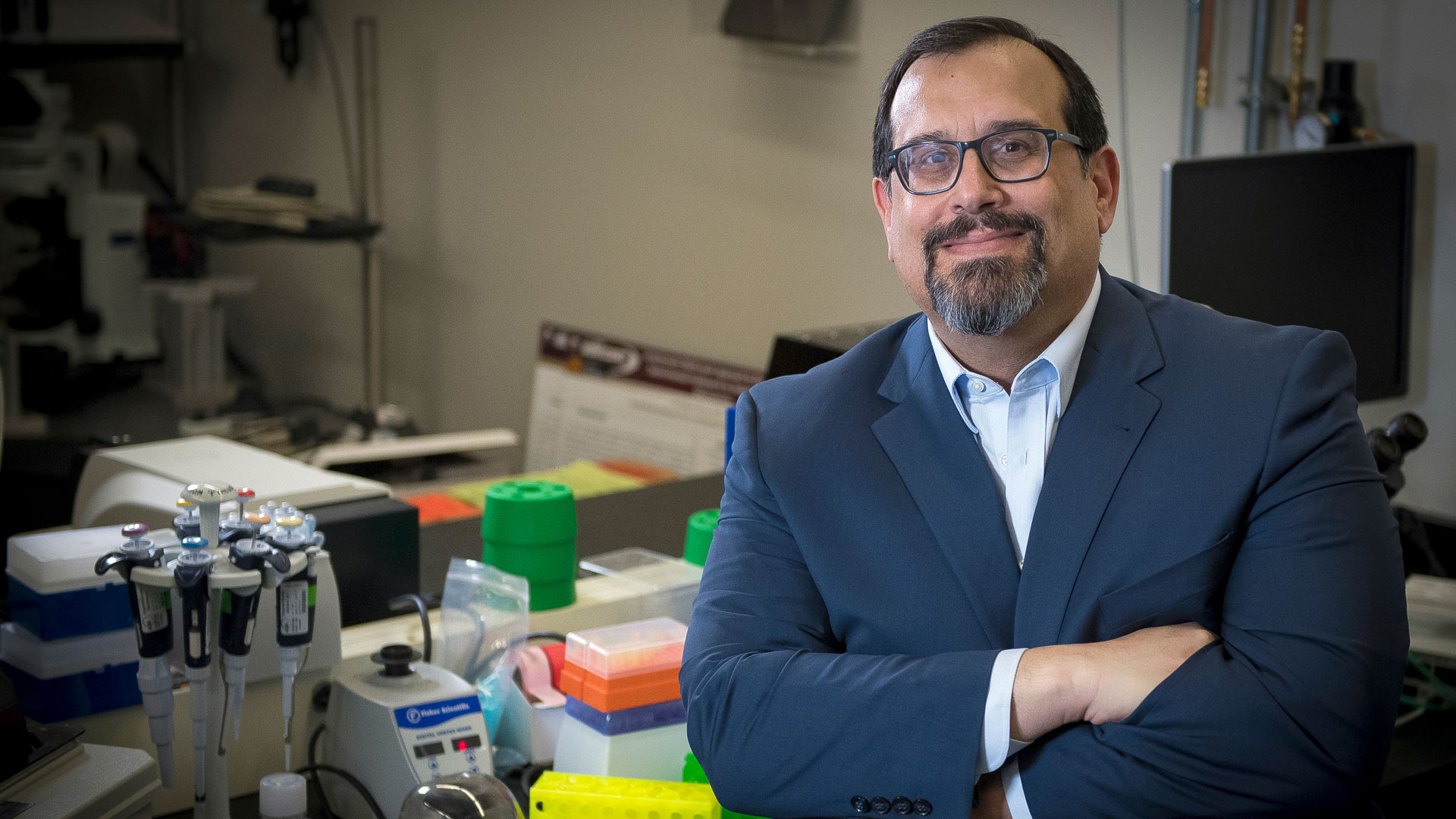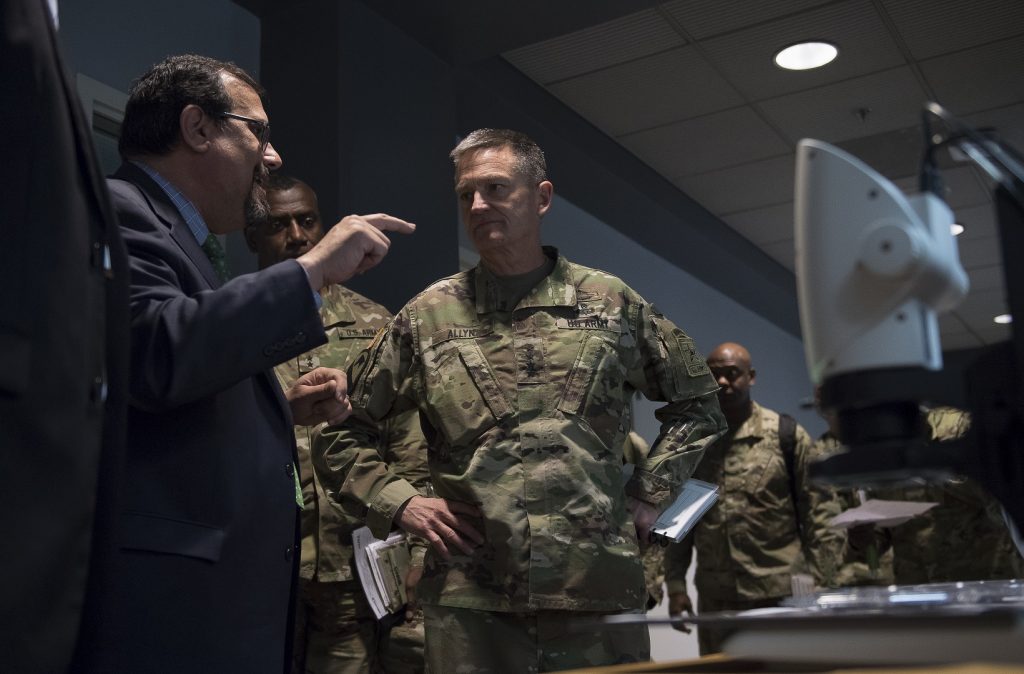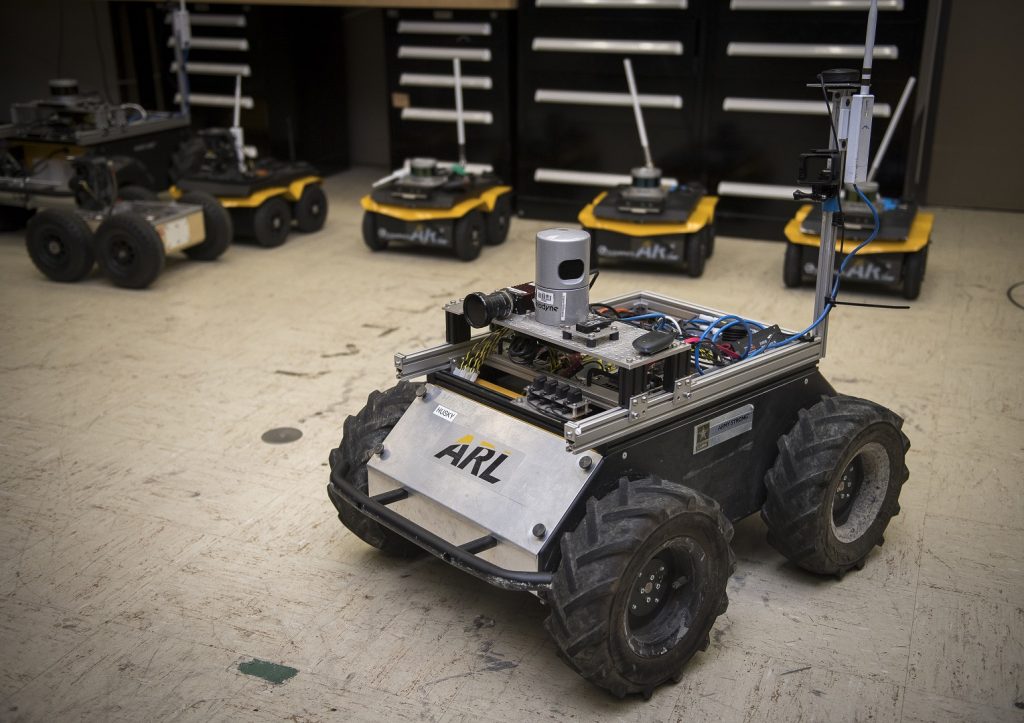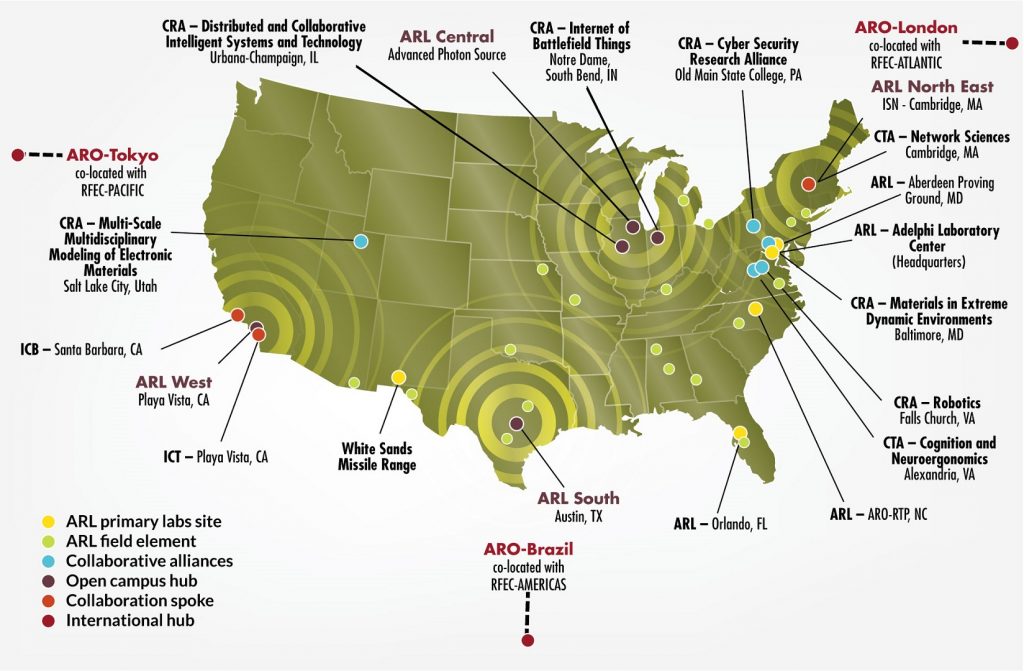
Dr. Philip Perconti leads the Army’s “corporate lab” with the intimate involvement of warfighters, businesses, academia and other labs in a high-stakes, high-risk, no-time-to-waste environment focused on finding and developing blockbuster disruptive capabilities.
by Mr. Michael Bold
When Philip Perconti was 8 or 9, he discovered technology in the back of a television. Peeking into the back of his parents’ big color TV, he was spellbound by the glowing tubes. “It made me very curious about how things worked,” he said.
When the TV stopped working, he discovered how: “I noticed that one tube stopped glowing. My father and I took the tube to the drugstore, put it in the test stand (yup, they had those in drugstores back then), and found that it was defective. We bought the replacement tube, put it back into its slot, turned the TV on, and it worked again! I was hooked.”
That hook, and hard work, led him all the way to the directorship of the U.S. Army Research Laboratory, some 45 years later.
After graduating from James Madison High School in Brooklyn, New York, Perconti joined the Navy. After one year in the Navy, Perconti knew he wanted to get a college degree. He not only got his bachelor’s, but followed that up with a master’s and a doctorate, all in electrical and computer engineering.
Since then, he has spent nearly 30 years working for the Army. “After the Navy, I co-opped with the Army at the night vision lab, and the rest is history,” he said. Perconti started out at the U.S. Army Communications-Electronics Research, Development and Engineering Center’s Night Vision and Electronic Sensors Directorate (NVESD), eventually becoming branch chief for imaging technology. In 1996 he became director of the Electronics and Photonics Technology Office at the National Institute of Standards and Technology. He returned to NVESD in 2000 as director of the Science and Technology Division, then moved to ARL in 2013 as director of the Sensors and Electron Devices Directorate before becoming acting director of ARL in April 2016. In June 2017, “acting” was removed from his title.
ARL, based in Adelphi, Maryland, is the Army’s premier laboratory for basic and applied research and analysis. With primary laboratory sites at Aberdeen Proving Ground, Maryland; Raleigh-Durham, North Carolina; Orlando, Florida; and White Sands Missile Range, New Mexico, as well as dozens of other sites throughout the U.S. and in three other countries, ARL researches weapons and materials, sensors and electron devices, computational and information sciences, human research and engineering, vehicle technology, and survivability and lethality analysis. The laboratory consists of about 2,000 civilian and military employees with an annual budget of over $1 billion.

Researchers from ARL and Washington State University have discovered a new type of energetic material that could triple the energy content of well-known explosives such as the ones pictured here. ARL has discovered that engagement with academic and industry partners at the early stage of development is crucial to technology transition and transfer because it allows the Army to better understand the partner’s technology and, in turn, helps the partner to better understand the Army’s requirements. (U.S. Army photo)
Among Perconti’s accomplishments at ARL are:
Modifying its use of cooperative research and development agreements (CRADAs). CRADAs allow Army and private sector researchers to set the terms for who does what research, who gets intellectual property rights, and who gets to develop what and for how long, while involving no exchange of funding. The new CRADA model has significantly lowered barriers for cooperation, enabling ARL researchers to more effectively transfer intellectual property to their partners, and has boosted the number of active CRADAs from 20 in 2014 to now more than 400.
Expanding ARL’s Open Campus, begun in 2014 by his predecessor, Dr. Thomas P. Russell, now the deputy assistant secretary of the Army for research and technology. Open Campus was designed to create a science and technology (S&T) ecosystem emphasizing interdependent collaborative research. Under Perconti’s leadership, ARL has leveraged more than $70 million in in-kind contributions for Army-focused research through Open Campus initiatives.
ARL Extended, with hubs at ARL West, at the University of Southern California; ARL South, at the University of Texas at Austin; ARL Central, at the University of Chicago; and ARL Northeast, at Northeastern University in Boston. ARL has also established CRADAs with regional universities and partners around each hub; ARL, for instance, has one CRADA that covers the entire University of Texas system.
Development of technology transfer, with small businesses licensing ARL intellectual property.
In an email exchange, Army AL&T asked Dr. Perconti about the future of ARL and its role in the Army.
Army AL&T: Everything we’re hearing about Army acquisition is about making it faster and more responsive. How does this new emphasis, along with the Futures Command, change ARL’s mission, if at all? Will you have to adjust Army S&T efforts to ensure quick transition of scientific knowledge and development of a rapid prototyping capability?
Perconti: ARL’s mission still remains the same. We’re the corporate laboratory for the Army, and our mission is discovery, innovation and transition of science and technology knowledge and capabilities that address the Army modernization priorities. We have strategically developed research programs that align with the Army’s priorities and are aggressively looking to develop disruptive technologies in those key areas.
The Army vision states the Army will be ready to deploy, fight and win decisively, against any adversary, in a joint, multidomain, high-intensity conflict, and will maintain its ability to conduct irregular warfare while simultaneously deterring adversaries anytime, anywhere, by 2028; ARL is looking at 2028 and beyond. ARL has a plenoptic view of science and technology: We look at our research through many lenses across time. ARL researchers focus on the future, while simultaneously looking to exploit breakthroughs for nearer-term innovation―for example, to address excessive wear in large-caliber gun tubes.
Recently, ARL connected long-running materials research in tantalum “cold spray” technology with collaborative partners to form the basis for new gun-tube material improvement programs. Tantalum is a high-temperature- and wear-resistant material that provides longer service life and is the only material tested that can withstand the higher temperatures of advanced propellants. Cold spray is the only technique developed that can apply a tantalum bore coating for large-caliber cannon tubes.
We always look for opportunities to roll out disruptive technologies as they emerge. If we have an S&T breakthrough with the potential to change the way the Army fights and wins our nation’s wars, then it is our responsibility to rapidly work to get that innovative technology pushed toward a transition partner. Early-onset partnering is a method ARL uses to quickly transition knowledge, ideas, information and technology. To effectively apply the science and technology ARL develops, it’s important to understand the capability gaps and how S&T can be used to meet the need. This is where partnering early with academia, industry, RDECs [research, development and engineering centers] and innovation hubs becomes crucial in order to develop a comprehensive partnership that is capable of delivering a product from a theoretical concept to a disruptive technology.

ARL is collaborating with Uber to develop a quieter rotor system for vertical takeoff and landing vehicles that could improve aeromechanic performance and advance the capabilities of unmanned aircraft systems. The organization has increased its use of CRADAs and other instruments to quickly transition research products to industry, RDECS, PEOs and the requirements community as soon as they show promise. (SOURCE: Defense Advanced Research Projects Agency artist concept)
Army AL&T: How would you define “disruptive”?
Perconti: Disruptive is a term used to describe a drastic improvement to the way a technology is produced, enhanced or performs. The improvement is so great that it disrupts the linear incremental process in the advancement of a technology.
Army AL&T: In a speech you gave to the Federal Laboratory Consortium in May, you discussed the need for early involvement of the warfighter, academia and industry when developing new capabilities. Talk about that.
Perconti: The problems we face today are way too complex to solve either in isolation or sequentially. Early and intimate collaboration between warfighters, large and small businesses, academia and government labs is a must in the 21st century and a major objective of the Army Futures Command. In the current global environment, we no longer are afforded years of lead time in developing new capabilities for the Army. By bringing all parties together early in a collaborative environment, we can foster and accelerate new concepts, ideas and capabilities through an Army innovation ecosystem focused on delivering new capabilities as quickly as possible.
Army AL&T: ARL needs to respond to immediate needs from the field; to build capabilities needed in the next 10-25 years; and to look to the future for capabilities that will be required 30-50 years from now. How does the laboratory respond adequately to such a wide-ranging mission, and how does that affect the laboratory’s research priorities? How does the lab incorporate new strategic thinking about the way the Army of the future will fight? Talk about the long view versus quick capabilities.
Perconti: As the creators and custodians for the Army’s far-term S&T, ARL’s mission is to understand and translate cutting-edge science into actionable knowledge that will enable future Army capabilities. Often risk of failure is high in research, because project outcomes are uncertain. However, we learn from every experiment, and we use this knowledge to reduce the uncertainty in S&T options and to identify and quantify technology risk, so that our leadership has the knowledge necessary to make informed decisions.
Army AL&T: Where do you see ARL doing its most important “revolutionary” work in the near term? How about the most important evolutionary developments? Discuss incremental versus disruptive technologies.
Perconti: Disruptive innovation is our sweet spot. We seek to change the way the Army fights and wins our nation’s wars by moving trajectories of technologies off the existing path and into new directions with the potential for greater warfighting capability―we want the U.S. Army to own technological surprise.
Take, for example, the Generation II Advanced Combat Helmet fielded to warfighters last spring. It’s 22 percent lighter than the legacy Advanced Combat Helmet, based on the use of ultra-high-molecular-weight polyethylene and other materials. ARL developed the manufacturing science for this helmet as part of foundational research with academic and industry partners. ARL is working with its partners—PEO [the Program Executive Office for] Soldier, NSRDEC [the U.S. Army Natick Soldier Research, Development and Engineering Center], industry, academia—on further enhancements in helmet technology to provide greater protection from ballistic threats and less burden for the warfighter.
Our next disruption will be in Soldier protection systems that use 2D materials, such as graphene and other lightweight materials. ARL researchers are focusing on designing new polymers for superior protection capabilities by unraveling the complex relationship between polymer chemistry, microstructure and energy absorption and, by doing so, increasing the materials’ ballistic protection properties to stand up against tougher threats that are certain to be developed by adversaries. If successful, this technology will set the precedent for protection with extremely light weight.
Army AL&T: What role do you see the lab playing in the new Futures Command? Does the work of the new Futures Command influence ARL’s funding?
Perconti: ARL was established in 1992 to become a world-class laboratory focused on gathering and generating land warfare technologies needed by the Army. Now, as the Army Futures Command [AFC] prepares to lead the Army’s future force modernization enterprise, ARL will emphasize its role as the Army’s corporate research laboratory by strengthening its focus on high-risk, high-payoff research, providing broader support for S&T across AFC, and representing AFC’s S&T interests across the worldwide scientific community.
ARL is further refining the way we look at S&T in support of the Army and how to quicken the transfer of knowledge that will lead to increased capabilities. The essential research programs focus our efforts to pursue the Army’s vision beyond 2028.
Army AL&T: Part of the Army’s efforts to speed acquisition include more collaboration with industry and academia. ARL’s Open Campus initiative has been successful in doing this. What can Army acquisition learn from ARL’s Open Campus?
Perconti: Through Open Campus, ARL has been successful in dramatically increasing the number of partnerships with industry and academia. These partnerships include CRADAs, CAs [cooperative agreements], licensing, joint publishing, joint development of IP [intellectual property], staff exchanges and the sharing of facilities. ARL has discovered that engagement with partners at the early stages of development is crucial to technology transition and transfer. The early engagement allows the Army to understand the partner’s technology and manufacturing capabilities while the partner better understands the Army’s unique requirements. This early mutual understanding shapes the opportunities for rapid acceleration of capabilities to the Soldier.

Perconti speaks with Gen. Daniel B. Allyn, then-vice chief of staff of the Army, during Allyn’s April 2017 visit to ARL. ARL was established in 1992 to focus on gathering and generating land warfare technologies needed by the Army. With the recent stand-up of the Army Futures Command, ARL will focus on high-risk, high-payoff research to support S&T across the new command and represent its S&T interests worldwide. (U.S. Army Research Laboratory photo)
Army AL&T: Talk about CRADAs. You’ve greatly expanded the use of CRADAs at ARL.
Perconti: A cooperative research and development agreement is an agreement between a federal laboratory and a nonfederal party to perform collaborative research and development in any area that is consistent with the federal laboratory’s mission. CRADAs are the most frequently used mechanism for formalizing interactions and partnerships between private industry or academia and federal government laboratories.
Under the statute that authorizes CRADAs [15 U.S.C. 3710a], a federal laboratory may provide personnel, services, facilities and equipment, but no funds, to the joint research and development effort. A nonfederal party may provide funds, in addition to personnel, services, facilities and equipment to the joint research and development effort.
ARL uses CRADAs with academic institutions or industry to maximize collaboration, minimize bureaucracy and yield mutual benefit by taking full advantage of our Open Campus efforts. The changing pace of science and technology around the country has necessitated that ARL transform and adapt its business practices and be proactive about identifying game-changing S&T across the country. ARL has stood up business-related efforts to improve business acumen, information technology and strategy management.
Moreover, ARL Extended is ARL’s effort to create strong, enduring S&T partnerships by co-locating Army research and development personnel in close collaboration with academia and industry. In this aspect of the Open Campus initiative, ARL Extended leverages regional expertise and facilities to accelerate the discovery, innovation and transition of science and technology. Close collaboration with universities, startups and established companies working in regionally specific technical subject areas will directly benefit the Soldier and ensure our nation’s future strength and competitiveness.
Army AL&T: The CRADA that ARL has with Uber sounds fascinating and a little off the beaten track. How is it going to make for quieter aircraft? How did that come about?
Perconti: The research from the ARL-Uber collaboration will potentially deliver unprecedented capability for quieter rotor systems in a unique stacked rotor configuration, which involves two rotor systems stacked on top of each other and rotating in the same direction. This rotor concept may enable vertical take-off and landing vehicles to be quieter, while maintaining or improving aeromechanic performance. Partnering was initially conceived when Uber engineers met the Army researchers at the American Helicopter Society Aerospecialist meeting in January 2018 and, soon after, three months of discussions began about a potential collaboration. This is a win-win partnership because Uber is looking for technology to enable its urban transportation (the air taxi, Uber Elevate) and the Army is utilizing connections to Uber and its top industry partners to accelerate enabling silent operations as a capability for the future unmanned aerial vehicle fleet for the Soldier.

A small unmanned Clearpath Husky robot, which was used by ARL researchers to develop a new technique to quickly teach robots novel traversal behaviors with minimal human oversight. (U.S. Army photo by Jhi Scott)
Army AL&T: How do we accelerate developing capabilities in electronic warfare, cyber and artificial intelligence (AI)?
Perconti: Future warfare will see a rise in autonomous systems, and the U.S. Army could face a major threat from weaponized autonomous platforms, ranging from human-in-the-loop to full autonomy, that use rules of engagement that are less restrictive than current U.S. policy permits. The future will see the emergence of adversarial AI, which will lead to machine-on-machine warfare that infiltrates human decision-making timelines. Success in this battlefield intelligence race will arise from increasing AI capabilities as well as uncovering unique and effective ways to merge AI with Soldier knowledge and intelligence.
In particular, ARL’s efforts in human-agent teaming look at both how humans—Soldiers—interact with agents—robotic entities—and how those agents can be used to interact with humans. Part of that interaction involves developing an understanding of how humans communicate with robots and vice versa. The ability to have robots interpret commands the same way that humans interpret them is huge, but a game-changing technology would be having the robot anticipate what needs to happen next. This level of adaptive behavior will provide an overmatch capability in this battlefield space.
The Army requires adaptive AI―AI that will learn with little or no supervision using small data sets collected organically, that will quickly and easily adapt to new tasks that will provide context and understanding in unstructured environments, and will defeat attacks from adversarial machines.
The U.S. Army AI Innovation Institute [A2I2, which will officially start in 2020] seeks to rapidly advance adaptive AI capabilities to enable fully autonomous maneuver. Adaptive AI will provide our warfighters with coup d’oeil—the ability to recognize with one glance the tactical advantages and disadvantages on the battlefield using a heterogeneous mix of unmanned ground and aerial platforms that rapidly learn, adapt and reason faster than the adversary in a complex environment.
ARL also sees an important connection between AI and cyber and electronic warfare (EW), because effective conduct of cyber and EW battle is becoming increasingly difficult without AI-based intelligent agents. ARL executes research in developing such intelligent agents. These would assist Soldiers in defensive and offensive tasks that often unfold in fractions of a second, too fast for a human cognitive cycle.
Army AL&T: What is technology transfer, and why is it important?
Perconti: Technology transfer at ARL is the process by which existing knowledge, facilities or capabilities developed under federal R&D [research and development] funding are used to fulfill public and private needs. Every year, millions of taxpayer dollars go into funding research and development, with the intent to have a return on investment and move innovations from the laboratory to the hands of the Soldier or the commercial marketplace. Technology transfer from ARL spurs the generation of small business startups or spinoffs. Technology transfer may also spin in viable technologies that meet the warfighters’ requirements.
Technology transfer is truly a contact sport, and it is through a close coordination and collaboration among government, industry and academia that we are able to rapidly accelerate technologies and capabilities to the warfighter. From the start of the Open Campus initiative and through the advent of the Army Futures Command, ARL embraces an agile and entrepreneurial mindset to be expeditious in transition of research products to RDECs, industry, PMs [program managers] and PEOs, and the requirements community as soon as they show promise. With this in mind, we are aligned and ready to support AFC and the cross-functional teams in the pursuit of mid- and far-term capabilities.

ARL is based in Adelphi, Maryland, with primary laboratory sites at Aberdeen Proving Ground, Maryland; Raleigh-Durham, North Carolina; Orlando, Florida; and White Sands Missile Range, New Mexico, as well as dozens of other sites throughout the U.S. and in three other countries. Its efforts include collaborative research alliances (CRAs), collaborative technology alliances (CTAs) and other collaboration research entities, such as the Institute for Collaborative Biotechnologies (ICB) and the Institute for Creative Technologies (ICT). (SOURCE: ARL)
Army AL&T: Talk about academic entrepreneurship. Why is it important?
Perconti: Academic entrepreneurship is a major force in the U.S. economy. A large fraction of U.S. startups, including those that resulted in creation of some of the world’s largest corporations, originated at universities, inspired by academic research results and started by professors and students who saw a business opportunity in the research. The U.S. Army S&T enterprise, including ARL, seeks to make greater use of this major intellectual and economic force. This can be―and is already being―done in a number of ways. Army scientists and engineers often work with academic entrepreneurs, both before and after the creation of a new business, thereby benefiting from ideas and research that underpin a budding company. Furthermore, collaborative research between academic entrepreneurs and ARL can result in novel ideas that the academic entrepreneurs translate into tangible products. These, in turn, may contribute to the security needs of the United States.
For more information, go to the ARL website at https://www.arl.army.mil/.
MICHAEL BOLD provides contract support to the U.S. Army Acquisition Support Center. He is a writer/editor for Network Runners Inc., with more than 30 years of editing experience at newspapers, including the McClatchy Washington Bureau, The Sacramento Bee, the San Jose Mercury News, the Dallas Morning News and the Fort Worth Star-Telegram. He holds a B.J. in journalism from the University of Missouri.
Related Links
Dr. Philip Perconti speaks to the Federal Laboratory Consortium: https://www.arl.army.mil/www/default.cfm?video=101
“New Science Club,” Army AL&T, July – September 2016: http://usaasc.armyalt.com/?iid=143668#folio=180
ARL’s Open Campus: https://www.arl.army.mil/www/default.cfm?page=2357
ARL’s Collaborative Technology and Research Alliances: https://www.arl.army.mil/www/default.cfm?page=93
ARL Extended: https://www.arl.army.mil/www/pages/3133/ARLExtendedOverviewv2.pdf
“U.S. Army, Uber sign research agreement,” ARL Public Affairs, May 8, 2018: https://www.army.mil/article/204882/us_army_uber_sign_research_agreement
This article will be published in the October – December 2018 issue of Army AL&T magazine.
Subscribe to Army AL&T News – the premier online news source for the Army Acquisition Workforce.
![]() Subscribe
Subscribe







